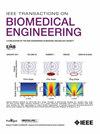Computational Fluid Dynamic Simulation of the Cerebral Venous System in Multiple Sclerosis and Control Patients: Are Hemodynamic Variances Evident in Multiple Sclerosis?
IF 4.4
2区 医学
Q2 ENGINEERING, BIOMEDICAL
引用次数: 0
Abstract
多发性硬化症和对照组患者脑静脉系统的计算流体动力学模拟:多发性硬化症患者的血流动力学变化明显吗?
目的一项调查旨在确定有助于评估人类疾病血管病理学的相关血液动力学参数。利用这些参数,本研究旨在评估多发性硬化症(MS)患者和对照组的脑静脉是否存在可能影响 MS 病因的血液动力学差异。进行磁共振成像(MRI),以计算解剖结构的三维几何图形和边界处的血流速度。为每位参与者创建了计算流体动力学(CFD)模型,并使用患者特定的边界条件进行模拟:结果:各组之间的压降和血管阻力没有明显差异。与对照组相比,多发性硬化症组的颈内静脉(IJV)横截面积较大(右颈内静脉:p = 0.04,左颈内静脉:p = 0.02),所有年龄段的多发性硬化症患者的直窦(ST)流速较高(p = 0.005)。血管阻力显示了脑静脉中可能与静脉压力增加相对应的区域。结论和意义:本研究表明,脑静脉的压力和血管阻力不太可能与多发性硬化症的病因直接相关。ST血流较高的发现可能与深静脉系统炎症加重相对应。阻力作为血管病理学的一种测量方法前景广阔,可用于全面研究循环系统各种其他疾病的血流血流动力学。
本文章由计算机程序翻译,如有差异,请以英文原文为准。
求助全文
约1分钟内获得全文
求助全文
来源期刊

IEEE Transactions on Biomedical Engineering
工程技术-工程:生物医学
CiteScore
9.40
自引率
4.30%
发文量
880
审稿时长
2.5 months
期刊介绍:
IEEE Transactions on Biomedical Engineering contains basic and applied papers dealing with biomedical engineering. Papers range from engineering development in methods and techniques with biomedical applications to experimental and clinical investigations with engineering contributions.
 求助内容:
求助内容: 应助结果提醒方式:
应助结果提醒方式:


